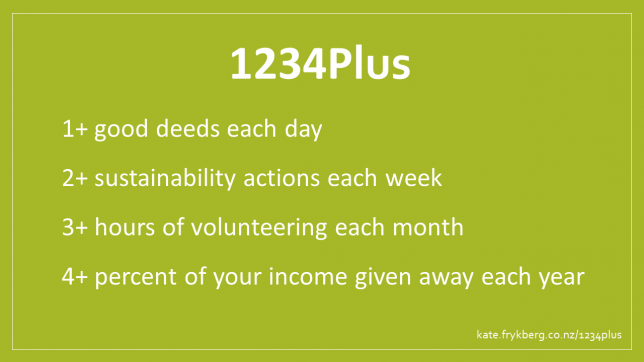What does it mean to live a generous life? And how do we articulate and measure the different ways in which to be generous? 1234Plus is my suggested model for considering generosity, and consists of:
- 1+ good deeds each day
- 2+ sustainability actions each week
- 3+ hours of volunteering each month
- 4+ percent of your income given away each year
 (You can download the above graphic as a PDF poster)
(You can download the above graphic as a PDF poster)
Most of my work involves the giving of money, or philanthropy, which is one dimension of generosity. But at least as important is the giving of time, or volunteering. And, more important still, is how we treat those around us and our planet. 1234Plus is a way of looking holistically at generosity, and can be used to consider where we are at and how we can improve.
Here’s how it works:
One (or more) good deeds each day: Doing a good deed simply means doing something kind or helpful for others; it’s an old concept from religious traditions and great thinkers, and it’s being reclaimed for the 21st century with movements like Good Deeds Day, coming up on April 15, and Random Acts of Kindness Day. Good deeds can be personal (helping a family member with home maintenance, taking a meal to friends with a new baby, sitting with a grieving relative) or civic (voting for your school board, providing feedback to your health provider, writing to your local politician on an issue you care about). Good deeds can also be more abstract – for example gratitude and reciprocity (which encourage the proliferation of good deeds) or forgiveness (which discourages the proliferation of bad ones).
Personally, I have been asking myself Benjamin Franklin’s evening question – “what good did I do today” most days for several years. Usually it is little things, for example taking the time to be with someone who needs a listening ear, although I try to engage civically too. There is a lot I could improve, in particular I would like to speak out more on casual racism and other everyday injustices.
Two (or more) sustainability actions each week: Our survival as a species depends on a planet able to sustain us – and, given the combined consumption of more than 7.6 billion humans, acting sustainably is about self-preservation as well as generosity. Easy examples include buying local, taking public transport instead of driving, speaking up on environmental issues, picking up rubbish and planting trees – more ideas here.
I have made a start on this aspect of personal generosity, but much more is possible. We grow veggies, keep chickens, try to avoid plastic bags and have moved from a two-car family to one aging hybrid. (We use combination of buses, walking, cycling, taxis and Uber for the times when we previously used two cars; it has been a surprisingly easy transition and saves money too.) The next small thing I intend to add is taking our own containers and keep cups when buying takeaways or coffee – because re-using is better than recycling.
Three (or more) hours of volunteering each month: Volunteering is “work done of one’s own free will, unpaid, for the common good,” and almost all of us can find at least a few hours a month to give to a cause we care about. In Aotearoa NZ, volunteering contributes significantly to our GDP (1.7% in 2013). But, despite the fact that that volunteering and altruism generally is good for our mental health, there has been a significant decrease in the number of volunteer hours in recent years, and it is time to reclaim and rejuvenate volunteering. Examples of volunteering include helping a kid’s sports team, pitching in at the marae, sorting goods for a charity shop, driving a van for people experiencing disabilities. Local volunteer centres are great places to find volunteer opportunities.
Personally, I have volunteered all my adult life and currently this includes the work I do through Te Muka Rau Charitable Trust as well as some mentoring and occasional free consulting. I would like to change the balance of my volunteering so it is a little more grass-roots and hands-on.
Four (or more) percent of your income given away each year: Why am I suggesting 4% or more of annual income as a percentage for financial giving? 4+ is just a number – probably impossibly high for a struggling family – and much too low for a wealthy one. We all need to figure out what is appropriate for our own circumstances; but, if we live comfortably and are not giving at least 4% to charitable causes and/or friends and relatives in need – why not? One common reason is that as the ability to give grows, the work required to give well grows too – especially when there are seemingly an infinite number of good causes and a large number of charities serving these causes. It can be helpful to work with organisations like community foundations, The Gift Trust, Philanthropy NZ or philanthropy advisors to figure out your approach and make the process easy. On the other hand, let’s not over-complicate financial giving and let perfection be the enemy of done. If in doubt, let’s err on the side of generosity and just give it away.
Personally, most of our financial giving is done through Te Muka Rau, the trust my husband Dave and I set up when we sold our Internet development company some years ago. This year we intend to increase our giving, both through our trust and personally.
The 1234Plus model for living a generous life isn’t a recipe, it isn’t a set of rules – each of us need to decide what is right for our own individual circumstances. 1234Plus is however a model for considering and improving how generously we live. I have found it useful, I hope you do too, and feedback is appreciated.